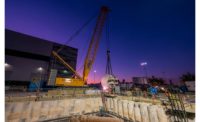Tunnels are being used increasingly in India, especially to cross borders in mountainous regions of the country.
“Precious experience in the Himalayan region has been gained following large numbers of tunnel projects,” said M.M. Madan, chairman, tunneling group, of the Association of Chambers of Commerce. In one instance, the 9-km Atal Tunnel was constructed using drill and blast New Austria Tunneling Method in Rohtang, at an altitude of 3000 m. (10,000 ft).
“The commissioning of the Atal tunnel has instilled confidence for tunnel construction in any kind of geology in the country,” said Col. Parikshit Mehra, Border Roads Organization (BRO). Construction on the tunnel was challenging because of ventilation and heavy snowfall in the winter, said Mehra. The Atal tunnel was developed on a bill of quantities contract because it had a long construction period and required regular cash flow, he added. Atal Tunnel has been designed for a traffic density of 3,000 cars per day and 1,500 trucks per day with a maximum speed of 80 km/hr. It has an upgraded electromechanical system, including semi-transverse ventilation system.
The BRO plans to construct multiple tunnels about 100 km long over the next few years, with 60% of the tunnel length in the eastern mountainous states of Arunachal Pradesh, and Jammu and Kashmir.
At the same time, India has also announced it will close 19 tunnels on its borders with China and Pakistan because of elevated tensions with those countries.
Elsewhere, Nitin Gadkari, Indian minister for road transport and highways, launched the first blasting for construction on the 14.15-km Zojila tunnel in October. At 3,000 m, one of the longest in Asia, the tunnel will provide all-year connectivity between the cities of Srinagar and Leh. The tunnel is considered important to defend the country. The project is being built by Megha Engineering & Infrastructure Ltd.
TBMs are also being used by the Mumbai Metro Rail Corporation (MMRC), a joint venture between the government of India and the state of Maharashtra. The JV is building Line 3 of the 33.5km Mumbai metro corridor, with the majority of stations located underground. In addition to TBMs, the New Austrian tunneling method and cut and cover are being used.
At one point, 17 TBMs were being used for construction of twin tunnels on the line, S.K. Gupta, director of projects MMRC, said at a recent conference. At many locations, tunnels pass directly under existing buildings and structures, some of them heritage structures. To limit disturbance, the agency is using vibration-absorbing tracks. The ingress of water and weak geology have created barriers that slowed down work. Controlled blasting, lattice girder and rock bolts were required in some areas.
About 1.4 million passengers are expected to use the line when it opens late this year. Ridership is projected to increase to 1.7 million by 2031.



Post a comment to this article
Report Abusive Comment